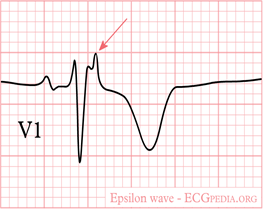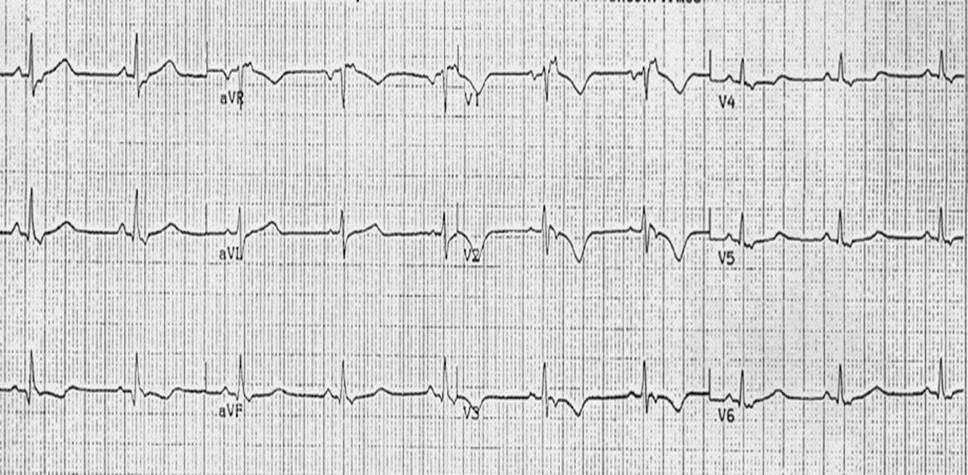Arrhythmogenic right ventricular dysplasia ECG
|
Arrhythmogenic right ventricular dysplasia Microchapters |
|
Differentiating Arrhythmogenic right ventricular dysplasia from other Diseases |
|---|
|
Diagnosis |
|
Treatment |
|
Arrhythmogenic right ventricular dysplasia ECG On the Web |
|
American Roentgen Ray Society Images of Arrhythmogenic right ventricular dysplasia ECG |
|
Directions to Hospitals Treating Arrhythmogenic right ventricular dysplasia |
|
Risk calculators and risk factors for Arrhythmogenic right ventricular dysplasia ECG |
Editor-In-Chief: C. Michael Gibson, M.S., M.D. [1]
Overview
An EKG abnormality is present in 90% of patients with AVRD. These abnormalities include inverted T waves beyond lead V1 in young males, the presence of right bundle branch block, the presence of an epsilon wave, and the presence of right ventricular outflow tract ventricular tachycardia with a left bundle branch block pattern.
Electrocardiograph Characteristics of ARVD/C
Electrocardiograph tracings of ARVD/C are typically featured by the presence of complete or incomplete right bundle branch block (RBBB) morphologies, T wave inversions, terminal QRS fractionation, and slurred S wave upstrokes that are present predominantly in leads V1 through V3. Among these EKG findings, the presence of epsilon wave or prolonged upstroke of S wave beyond 55 ms has been shown to correlate with disease severity.
T Wave Inversion Beyond Lead V1
The most common EKG abnormality seen in ARVD is T wave inversion in leads V1 to V3. The presence of T wave inversion beyond V1 in a young athlete should always raise a suspicion of ARVD. However, this is a non-specific finding, and may be considered a normal variant in right bundle branch block (RBBB), women, and children under 12 years old.
Shown below is an example of arrhythmogenic right ventricular dysplasia with terminal QRS complex deflections and T wave inversions.

Shown below is an example of arrhythmogenic right ventricular dysplasia with sharp discrete deflections in the terminal portions of QRS complex with T wave invertions.

Right Bundle Branch Block
RBBB itself is seen frequently in individuals with ARVD. This may be due to delayed activation of the right ventricle, rather than any intrinsic abnormality in the right bundle branch.
Epsilon Wave
The epsilon wave is found in about 50% of those with ARVD. This is described as a terminal notch in the QRS complex. It is due to slowed intraventricular conduction. The epsilon wave may be seen on a surface EKG; however, it is more commonly seen on signal averaged EKGs.

Signal averaged ECG
Signal averaged ECG (SAECG) is used to detect late potentials and epsilon waves in individuals with ARVD.
Ventricular Ectopy
Ventricular ectopy seen on a surface EKG in the setting of ARVD is typically of left bundle branch block (LBBB) morphology, with a QRS axis of -90 to +110 degrees. The origin of the ectopic beats is usually from one of the three regions of fatty degeneration (the "triangle of dysplasia"): the RV outflow tract, the RV inflow tract, and the RV apex.
Right Ventricular Outflow Tract Ventricular Tachycardia
The presence of right ventricular outflow tract ventricular tachycardia should prompt suspicion of AVRD.
Electrocardiographic characteristics include the following:
- Atrioventricular dissociation similar to all patients with VT
- Heart rate > 100 beats per minute
- QRS duration > 120 milliseconds
- Left bundle branch block pattern or morphology with negative deflection in V1 and V2
- A rightward and inferior axis deviation (approximately +90 degrees)
Shown below is an example of arrhythmogenic right ventricular dysplasia with right ventricular outflow tract ventricular tachycardia. Note the negative deflection in V1 and V2 and left bundle branch block pattern to the tachycardia.

Shown below is an example of arrhythmogenic right ventricular dysplasia with terminal QRS deflections in V1 and V2
